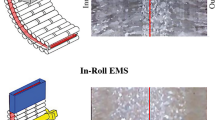The consequences of a world economic crisis entail new problems for the management of metallurgical plants. These include a need to increase the productivity of continuous casting machines, an expansion of their grade and dimensional assortments, a reduction in the prime cost of production, energy consumption and ecological load on the environment, as well as an improvement in the quality of finished products. The quality of steel workpieces produced in continuous casting machines is considerably dependent on the equipment design features and applied casting technology. Even when using state-of-the- art continuous casting equipment, a group of identified defects in continuously cast workpieces — including shrinkage porosity, pipe segregation, and developed ingot dendritic structure — cannot be excluded. However, such defects can be prevented, or their development suppressed, by applying various methods involving external physical actions on the hardening melt, which assume an intensive interference in the process of ingot crystallization during casting. One of the most effective and technological methods of this action involves the application of a guided motion created in a liquid phase of a crystallizing ingot, in particular, by using electromagnetic stirring devices. The article presents the results of mathematical simulation studies of magnetohydrodynamic processes occurring during the electromagnetic stirring of a steel melt.





Similar content being viewed by others
References
I. Yu. Kryukov, S. M. Gorbatyuk, L. M. Glukhov, and A. Yu. Zarapin, “Development of a new horizontal continuous casting machine construction for nonferrous and precious metal billets,” Metallurgist, 61, No. 11–12, 1009–1015 (2018).
V. A. Efimov and A. S. El’darkhanov, Physical Methods Effecting the Processes of Alloy Hardening [in Russian], Metallurgiya, Moscow (1995).
I. Yu. Kryukov, S. M. Gorbatyuk, and M. G. Naumova, “Mathematical model of the crystallizing blank’s thermal state at the horizontal continuous casting machine,” Matec Web of Conferences, 129, 02010 (2017); DOI: https://doi.org/10.1051/matecconf/201712902010.
Z. K. Kabakov, Yu. A. Samoilovich, V. F. Chirikhin, A. G. Podorvanov, E. R. Shifman, and V. M. Bryksin, Application of Electromagnetic Effects for Improving the Metal Quality and Productivity of Continuous Casting Machines [in Russian], Monograph, ChGU, Cherepovets (2008).
A. N. Carlov, I. P. Kondratenko, A. P. Rashchepkin, “Comparative analysis of magnetoelectric stirrers for a liquid metal in the CMM mold,” Elektromekhanicheskie Sistemy I Mekhanizatsiya, Iss. 2(14), 22–27 (2011).
S. I. Shakhov, A. S. Smolyakov, and G. I. Nikolaev, “Modernization of billet and bloom continuous casting machines for the purpose of expanding the dimensional and grade assortment of workpieces, improving their quality, and increasing the productivity,” Chernye Metally, No. 3(999), 25–29 (2015).
J. Zeng, C. Weiqing, and Z. Senlin, “Development and application of final permanent magnet stirring during continuous casting of high carbon rectangular billet,” ISIJ Int., 55, No. 10, 2142–2149 (2015).
V. V. Devyatiarova, E. E. Balakhnina, and L. M. Valeeva, “Development of a mathematical model for a workpiece heating and cooling in a protective medium while treatment under pressure,” Defect and Diffusion Forum, 410, 115–122 (2021); https://doi.org/10.4028/www.scientific.net/ddf.410.115.
N. A. Chichenev, O. N. Chicheneva, A. O. Karfidov, and A. N. Pashkov, “Selection of laser processing parameters for hot stamping tools based on mathematical planning of the experiment,” CIS Iron and Steel Review, 22, 37–40 (2021); DOI: https://doi.org/10.17580/cisisr.2021.02.07.
K. N. Vdovin, V. V. Tochilkin, and I. M. Yachikov, Continuous Casting of Steel [in Russian], Izd-vo Magnitogorsk. Gos. Tech. Unta, Magnitogorsk (2012).
N. P. Lyakishev and A. G. Shalimov, Development of Continuous Casting Technology [in Russian], Eliz, Moscow (2002).
N. A. Shah and I. Moore, “Review of the Effects of Electromagnetic Stirring (EMS) in Continuously Cast Steel,” Iron and Steelmaker, 9, No. 10, 31–36 (1982).
Z. K. Bars, Yu. A. Samoilovich, and V. F. Chirikhin, “Methodology for the substantiating the parameters of conductive electromagnetic stirring devices for improving the quality of continuously cast workpieces,” Fundamental’nye Issledovaniya, No. 1, 76–78 (2006).
A. D. Bardovsky, L. M. Valeeva, and I. I. Basyrov, “A plant with a rotary jet grinder to produce small fractions of mineral raw material,” IOP Conf. Series: Materials Science and Engineering, 971, 052004 (2020); DOI:https://doi.org/10.1088/1757-899X/971/5/052004.
K. N. Vdovin, S. I. Shakhov, V. V. Tochilkin, A. M. Filatov, and V. V. Tochilkin, “Designs and operational analysis of equipment for feeding steel into the tundish of a double-stranded CMM,” Izv. Volgogradskogo gos. tekh. un-ta, No. 7, 67–70 (2019).
G. A. Dubskii, K. N. Vdovin, S. I. Shakhov, L. G. Egorova, A. A. Nefed’ev, “MHD method for calculating some parameters of liquid metal flow and solidification,” Russian Metallurgy (Metally), No. 12, 1390–1396 (2020).
S. I. Shakhov, I. M. Yachikov, N. A. Feoktistov, and K. N. Vdovin, “Use of an electromagnetic brake in a continuous casting mold when a DC magnetic field is applied to a liquid metal,” Russian Metallurgy (Metally), 2021, No. 12, 1534–1537 (2021).
S. I. Shakhov, A. S. Smolyakov, and Yu. M. Rogachikov, “Works of VNIIMETMASH on the use of electromagnetic stirring in continuous casting of steel,” Chernaya Metallurgiya. Byul. NTiEI, No. 10(1310), 79–84 (2015).
Author information
Authors and Affiliations
Corresponding author
Additional information
Translated from Metallurg, Vol. 66, No. 5, pp. 19–24, May, 2022. Russian DOI: https://doi.org/10.52351/00260827_2022_05_19.
Rights and permissions
Springer Nature or its licensor holds exclusive rights to this article under a publishing agreement with the author(s) or other rightsholder(s); author self-archiving of the accepted manuscript version of this article is solely governed by the terms of such publishing agreement and applicable law.
About this article
Cite this article
Shakhov, S.I., Kabakov, Z.K., Gorbatyuk, S.M. et al. Improvements to Electromagnetic Stirring Systems for Billet and Bloom Continuous Casting Machines. Part 1. Metallurgist 66, 510–517 (2022). https://doi.org/10.1007/s11015-022-01354-7
Received:
Published:
Issue Date:
DOI: https://doi.org/10.1007/s11015-022-01354-7




